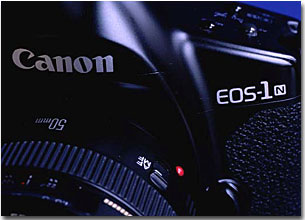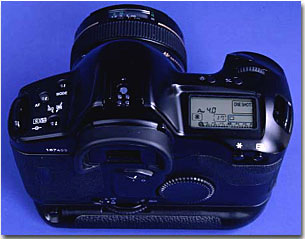Canon EOS-1n
Text and photography copyright 2000, James Erhardt
With the introduction in early 2000 of Canon’s new flagship camera, the EOS-1V, the EOS-1n has started to fade into history. But, it has been such a stalwart of the pro and advanced amateur market that it could be many years indeed until the last of them are retired from service.
Jim Erhardt, publisher of the excellent web siteNature Photographers.nethas contributed this review which should help newcomers to the marque become familiar with the 1n’s features and capabilities. My first-look review of the new EOS-1V can be foundhere. (MR)
Unveiled in 1994 as the replacement for Canon¹s ground breaking EOS 1, the EOS 1n requires little introduction.

Used extensively by professional and advanced amateur photographers world wide, the 1n quickly gained a reputation for high performance and durability. The first time I picked one up, I immediately knew that it would not only fulfill my practical requirements, but also meet my expectations of what a fine autofocus SLR should be.
It takes only a quick look to see that the 1n is a superbly crafted, high quality machine. While some have made an issue of its weight, it¹s no heavier than most other‚³pro² camera bodies. In fact, I find its heft reassuring, giving a feeling of quality lacking in most‚³consumer² level camera bodies. The feel and operation of its controls leaves no doubt that this is one, heavy-duty piece of equipment.
Optional Power Booster Drive E1 or Battery Pack BP-E1 attach to the bottom of the camera, forming a nearly seamless union. Unlike some other cameras, one has to look very closely to see that they¹re actually two separate pieces. The pieces join together not only in a cosmetically pleasing fashion, but also in a mechanically solid manner, making the combination rock solid and wobble free when attached to a tripod. As trivial as this may sound, this virtue was a welcome relief over my previous equipment. I use the BP-E1 battery pack exclusively with my 1n as it provides two independent power sources for the camera; a 2CR5 lithium battery in the grip and four double-A batteries in the pack. A switch on the bottom of the pack allows fast and convenient switching between the two power sources, ensuring I¹ll never lose a shot due to depleted batteries. I keep the pack loaded with NiMH double-A rechargeable batteries. I¹ve owned the camera for nearly 3 years and have yet to replace the 2CR5 lithium that I use strictly as a back up.
The 1n has far more capability and features than I normally use. With fourteen custom functions, the camera can be tailored to any user¹s preference. The custom functions I use on a regular basis include CF2, which leaves the film leader out and CF12, which enables mirror lock-up. Mirror lock-up can be used alone, where two separate trips of the shutter are required or in combination with the 2 or 10-second self-timer. When I use mirror lock-up (which is quite frequently), 9 out of 10 times it will be in combination with the 2-second timer and without the use of the remote shutter release cable.
The 1n offers five exposure-metering patterns, of which any three are instantly accessible from the top panel without the use of custom functions. The first metering selection can be set for either a 16-zone evaluative system or, through the use of CF8, a traditional center-weighted pattern. The second metering selection is a 9% partial pattern, which I find very practical. The third selection, via CF13, is the choice of a‚³fat² 3.5% spot pattern that can be tied to any one of the five focusing points or a‚³fine² 2.3% pattern fixed to the central sensor. I leave my 1n set on 16-zone evaluative for selection 1 and 3.2%‚³fat² spot for selection 3. With a push of a button and a spin of the main control dial, I can instantly select between evaluative, partial or spot. I have found evaluative metering to be quite accurate, even under moderately backlit situations. However, when the going gets rough with little or no mid-tone values in the frame, I switch to partial or spot and set exposure the‚³old fashioned² way. There¹s an analog scale in the viewfinder with 1/3 stop divisions, making exposure calculation in difficult lighting conditions much easier to judge.
As with all modern 35mm SLRs, there is the usual selection of exposure modes, including shiftable program, aperture priority, shutter priority, manual and Canon¹s unique depth-of-field program. For most of my photography, I employ evaluative metering in combination with aperture priority exposure control. However, when a difficult lighting condition presents itself and I choose to use partial or spot metering, I also switch to manual exposure mode. In combination with the analog scale in the viewfinder, using the main control dial to set shutter speed and the command dial for aperture selection, working with the 1n in manual mode is a pleasure.

The 1n is equipped with a 5-zone autofocus system that is very capable, as witnessed by the extraordinary images taken with it over the last 6 years. While I rarely make use of the camera¹s full autofocusing capability, the 5-zones come in handy for fast moving subjects. The focusing system will‚³hand off² the moving subject from one sensor to another, reliably keeping the subject in sharp focus. More often than not, I simply use the center sensor, lock focus using focus priority (One-Shot Autofocus) mode, recompose and take the shot. If there¹s a lot of subject movement, I will activate all 5 sensors and use shutter-release priority (Al Servo Autofocus) mode. I have also fitted my 1n with a split-image rangefinder focusing screen, which I find useful for manually focusing macro and stationary subjects. In combination with Canon USM lenses, manually focusing the 1n is as easy as any fine, non-autofocus SLR. The depth of field preview button is conveniently located and easy to use, a real benefit when precise depth-of-field and fine focus adjustment are critical.
The 1n has far more features and capability than this short, subjective review has room to elaborate on. In the 3 years I¹ve owned this camera, it has never let me down. It works as well today as the day I bought it. Other virtues of the 1n I¹ve learned to appreciate over the years include the fact that it¹s an absolute pleasure to use under the most demanding situations. With a selection of five metering patterns and its ease of use in manual exposure mode, the 1n offers the tools to tackle any lighting condition. Mirror lock-up and depth-of-field preview are both very welcome and essential features for serious photography, as are the viewfinder shutter and the built-in dioptric adjustment. Interestingly, a few of the newer‚³pro² bodies do not include some of these features, even though they cost substantially more than what a new 1n can be purchased for today. I¹ve also come to appreciate the 1n¹s 100% viewfinder (which is not found on several of the new‚³professional/advanced amateur² camera bodies) and its illuminated LCD display. Its superb craftsmanship, good looks and rugged construction impart a‚³pride of ownership² feeling that is difficult to find with many other cameras. The longer I¹ve owned it and the more I have used it, the more I have come to admire this fine piece of equipment.
Supplies of new 1n cameras will no doubt dry up quickly as production ends in the coming months. While the new 1V (³one-vee²) will eclipse the 1n in high technology and autofocus performance, the 1n has made its mark in the world of professional photography and is destined to remain a‚³working classic² for a long time to come.
I certainly will not be abandoning mine anytime soon.
Text and photography copyright 2000, James Erhardt
You May Also Enjoy...
The Polar Bears of Churchill
WoodLife Photography and Tourshas two photo tours entitled "The Polar Bears of Churchill" running this fall. They concentrate mostly on polar bears, but that is
YES – The Photographer’s Watch
It's a cliche that sometimes still needs repeating. Photography is as much about light as it is about subject. For the landscape and nature photographer
